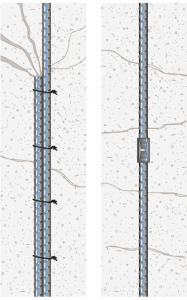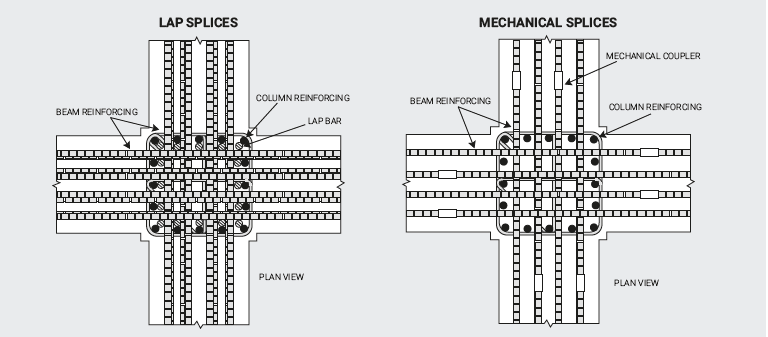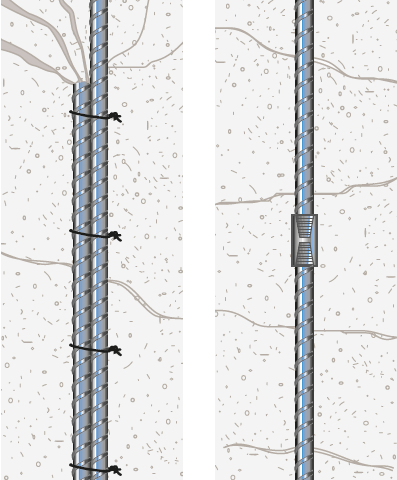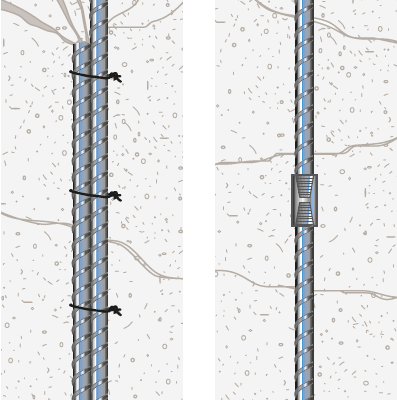
For many years, lap splicing has been the traditional method of connecting reinforcing bars . But as many structural engineers, architects and specifiers have discovered, lap splicing has very few advantages and quite a few disadvantages when compared to mechanical couplers. More and more engineers are specifying mechanical rebar connections over lap splices because mechanical connections afford a reliability and consistency that can’t be found with lap splicing.
In this blog, we will look at some of the maybe not-so-obvious advantages of using mechanical rebar splices versus lap splicing when comparing the total installed cost for a project.
The “Hidden” Costs of Lap Splicing
In a previous post, we considered the basic design considerations of a lap splice design compared to mechanical splices, such as the grade of steel, surface condition of the bar, size of bars, grade of concrete, position of the splice with respect to concreting and design loads. With all of those considerations, each design choice has a unique tradeoff with all of the other design choices.
When comparing the cost of using mechanical couplers against lap splicing, there may be several hidden costs in lap splicing that should be considered for a true apples to apples comparison
Material waste
Mechanical couplers allow the butt splicing of rebar, without the need to overlap. This means a more material-efficient design for engineers, reducing rebar lengths while improving structural integrity and minimizing the total amount of steel needed for a project.
Rebar size
The larger the rebar size, the more cost efficient mechanical couplers become in the overall cost of a project. Working with “small” diameter reinforcing bars may require the use of larger column dimensions to accommodate a greater quantity of bars. Using mechanical splices allows the option of larger diameter rebar in a smaller column while minimizing congestion. This reduced column size results in a more efficient design and an optimum use of floor space.
Rebar and freight costs
Longer rebar length or an increased amount of rebar needed to meet code requirements increases not only the supplied material cost, but also can increase the cost of freight, fabrication and the efficiency when space is at a premium.
Congestion
Speaking of space being at a premium, rebar couplers allow for designs to be less congested. Lap splicing increases rebar congestion at the lap zone and is one of the major causes for forming rock pockets and voids in the concrete. Mechanical splices eliminate these congestion problems, leading to better concrete consolidation and will make the overall job more cost effective through minimized job site problems.

Reusability – Reusable Forms
Couplers can be more efficient by enabling forms to be reused. During segmental pours, with the right coupler or accessory, load path continuity can be maintained in rebar without dowel bars protruding through forms. This prevents damage to costly forms, and makes their removal process faster and safer. This is also useful when utilizing slip/jump forming techniques for improving construction time and efficiency.
Find out more about nVent LENTON Form Saver Couplers and Accessories to improve reusability.
Prefabrication
Prefabricated rebar cages (PRCs) are built in fabrication yards on-site or in a remote location and then transported to the jobsite. These innovations have the potential to dramatically accelerate construction schedules and reduce fabrication costs while also allowing for more reliable quality control. Using mechanical couplers to connect PRC units greatly reduces labor, material and crane costs.
Read more about prefabrication and nVent LENTON solutions.
Project Time
Small amounts of efficiency over the length of a project can really add up to an improvement in on overall project timelines. Prefabrication, reusability and many other factors give mechanical couplers clear advantages over lap splicing. Here are some other advantages for mechanical couplers towards project time savings.
- Mechanical splices are fast and easy to install and require no specially skilled labor.
- Mechanical splices are cost effective by reducing labor costs and accelerating job schedules.
- Dowel bar substitutes reduce labor on site, form work costs and increase job site safety.
- Mechanical splices and Headed Bars eliminate congestion and simplify bar placing.
- Repair splices eliminate the cost of breaking away massive amounts of concrete. Amount depends on the structure and project size and requirements – design, detail, procure, thread, install, etc.
Read more about nVent LENTON helping to reduce installation time.
Depending on the project and applications, mechanical rebar couplers can reduce or eliminate some of the costs of lap splicing. It is important for engineers and designers to consider the not-so-obvious costs of a lap splicing design when comparing to the on-paper costs of mechanical couplers.
For more information on the advantages of mechanical rebar splicing systems, download our brochure or Contact Us.
Download the Mechanical Rebar
Splicing Systems Catalog
nVent LENTON Blog: Engineer’s Source for News and Advice
Stay on top of trends and expert insights in advanced mechanical rebar splicing systems and concrete solutions for cast-in place, pre-cast and masonry construction projects. Subscribers also are the first to hear about the latest innovations, research and new worldwide mechanical coupler approvals from nVent LENTON..



